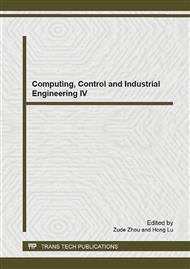[1]
J. M. Mendel. White-estimators for seismic data processing in oil exploration. IEEE Trans. Automatic Control. Vol. 22(1977), pp.694-706.
DOI: 10.1109/tac.1977.1101597
Google Scholar
[2]
J. M. Mendel, J. Kormylo. New fast optimal white-noise estimators for deconvolution. IEEE Trans. Geosci. Electron. Vol. 15(1977), pp.32-41.
DOI: 10.1109/tge.1977.294511
Google Scholar
[3]
J. M. Mendel. Optimal Seismic Deconvolution: An Estimation-Based Approach. Academic Press, New York, (1983).
Google Scholar
[4]
Z. L. Deng, H. S. Zhang, S. L Liu, L. Zhou. Optimal and self-tuning white noise estimators with applications to deconvolution and filtering problems. Automatica. Vol. 32(1996), pp.199-216.
DOI: 10.1016/0005-1098(96)85549-x
Google Scholar
[5]
Z. L. Deng. Unifying and universal optimal white noise estimators for time-varying systems. Control Theory appl. Vol. 21(2003), pp.143-146.
Google Scholar
[6]
J. A. Reocker, C. D. McGillem. Comparison of two-sensor tracking method based on state vector fusion and measurement fusion. IEEE Trans. Aerospace and Electronic Systems. Vol. 24(1988), pp.447-449.
DOI: 10.1109/7.7186
Google Scholar
[7]
Q. Gan, C. J. Harris. Comparison of two measurement fusion methods for Kalman-filter-based multisensor data fusion. IEEE Trans. Aerospace and Electronic Systems. Vol. 37(2001), pp.273-280.
DOI: 10.1109/7.913685
Google Scholar
[8]
S. L. Sun. Multi-sensor information fusion white noise filter weighted by scalars based Kaman predictor. Automatica. Vol. 40(2004), pp.1447-1453.
DOI: 10.1016/j.automatica.2004.03.012
Google Scholar
[9]
X. J. Sun, Y. Gao, Z. L. Deng. Information fusion white noise deconvolution estimators for time-varying systems. Signal Processing. Vol. 88(2008), pp.1233-1247.
DOI: 10.1016/j.sigpro.2007.11.011
Google Scholar
[10]
X. J. Sun, Y. Gao, Z. L. Deng, C. Li, J. W. Wang. Multi-model Information Fusion Kalman Filtering and White Noise Deconvolution. Information Fusion. Vol. 11(2010), pp.163-173.
DOI: 10.1016/j.inffus.2009.06.004
Google Scholar
[11]
H. R. Hashemipour, S. Roy, A. J. Laub. Decentralized Structures for Parallel Kalman Filtering. IEEE transactions on Automatic Control. Vol. 33(1988), pp.88-93.
DOI: 10.1109/9.364
Google Scholar
[12]
B. D. O. Anderson, J. B. Moore. Optimal Filtering. Englewood Cliffs. New Jersey: Prentice-Hall, (1979).
Google Scholar
[13]
Z. L. Deng. Information Fusion Filtering Theory with Applications. Harbin: Harbin Institute of Technology, (2007).
Google Scholar


